
The sieges of Taunton were a series of three blockades during the First English Civil War. The town of Taunton, in Somerset, was considered to be of strategic importance because it controlled the main road from Bristol to Devon and Cornwall. Robert Blake commanded the town's Parliamentarian defences during all three sieges, from September 1644 to July 1645.
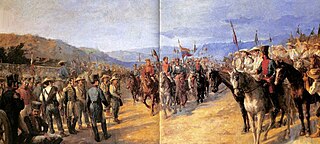
Bolívar's campaign to liberate New Granada also known as the Liberation Campaign of 1819 was part of the Colombian and Venezuelan wars of independence and was one of the many military campaigns fought by Simón Bolívar. In 1819 Bolívar led a combined New Granadan and Venezuelan Army in a campaign to liberate New Granada which had been under Spanish control since 1816.

The Battle of Boyacá (1819), also known as the Battle of Boyacá Bridge was a decisive victory by a combined army of Venezuelan and New Granadan troops along with a British Legion led by General Simon Bolivar over the III Division of the Spanish Expeditionary Army of Costa Firme commanded by Spanish Colonel José Barreiro. This victory ensured the success of Bolívar's campaign to liberate New Granada. The battle of Boyaca is considered the beginning of the independence of the north of South America, and is considered important because it led to the victories of the battle of Carabobo in Venezuela, Pichincha in Ecuador, and Junín and Ayacucho in Peru. New Granada acquired its definitive independence from the Spanish Monarchy, although fighting with royalist forces would continue for years.

The First Battle of Newbury was a battle of the First English Civil War that was fought on 20 September 1643 between a Royalist army, under the personal command of King Charles, and a Parliamentarian force led by the Earl of Essex. Following a year of Royalist successes in which they took Banbury, Oxford and Reading without conflict before storming Bristol, the Parliamentarians were left without an effective army in the west of England. When Charles laid siege to Gloucester, Parliament was forced to muster a force under Essex with which to beat Charles' forces off. After a long march, Essex surprised the Royalists and forced them away from Gloucester before beginning a retreat to London. Charles rallied his forces and pursued Essex, overtaking the Parliamentarian army at Newbury and forcing them to march past the Royalist force to continue their retreat.

The Battle of Cancha Rayada, was fought in Chile between South American patriots and Spanish royalists, during the Osorio's campaign in the South American wars of independence. The result was a defeat for the patriot forces, weeks later the patriots take their rematch at the Battle of Maipú.
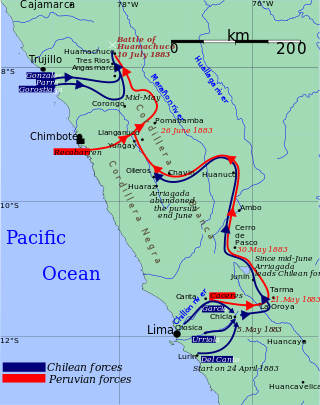
The Battle of Huamachuco was fought on the 10 July 1883, and it was the last major battle of the War of the Pacific. The Chilean soldiers, led by Colonel Alejandro Gorostiaga, decisively defeated the Peruvian army commanded by General Andrés Avelino Cáceres near the town of Huamachuco. This Chilean victory effectively eliminated Cáceres' Ejército de la Breña, ending any real threat or resistance in the Peruvian Andes. The Peruvian defeat paved the way for the Treaty of Ancón that finally put an end to the war. Also, one of Peru's greatest heroes, Colonel Leoncio Prado, died as a consequence of this battle.
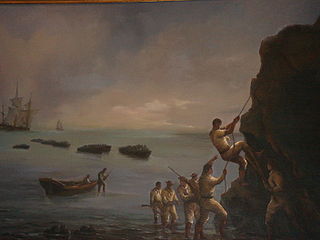
The Capture of Valdivia was a battle in the Chilean War of Independence between Royalist forces commanded by Colonel Manuel Montoya and Fausto del Hoyo and the Patriot forces under the command of Thomas Cochrane and Jorge Beauchef, held on 3 and 4 February 1820. The battle was fought over the control of the city Valdivia and its strategic and heavily fortified harbour. In the battle Patriots gained control of the southwestern part of the Valdivian Fort System after an audacious assault aided by deception and the darkness of the night. The following day the demoralised Spanish evacuated the remaining forts, looted local Patriot property in Valdivia and withdrew to Osorno and Chiloé. Thereafter, Patriot mobs looted the property of local Royalists until the Patriot army arrived to the city restoring order.
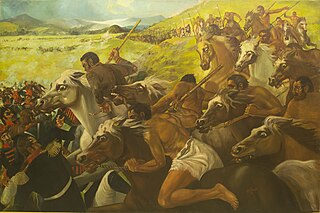
The Battle of Vargas Swamp fought on July 25, 1819, was an engagement of Bolívar's campaign to liberate New Granada. The battle involved a joint Venezuelan and New Granadan army commanded by General Simón Bolívar against the III Division of the Spanish Royalist Army commanded by Colonel José María Barreiro. The Battle of Vargas Swamp is considered one of most important battles of the Colombian War of Independence as it cleared the path for the Patriot army to advance towards Santafé de Bogotá, while also demoralizing the Royalist troops. Vargas Swamp was also the bloodiest battle of the 1819 New Granadan liberation campaign.
The Battle of New Ross also known as the Battle of Ballinvegga occurred on 18 March 1643 during the Irish Confederate Wars when the Leinster Confederates commanded by Thomas Preston were routed at Ballinvegga in County Wexford by Royalist forces commanded by the Marquess of Ormond.

The Battle of El Toro was fought near Maullín, Chile between Chilean patriots and Spanish royalists, during the Chilean War of Independence.

Events from the year 1814 in Chile
The Battle of Les Tres Acequias, fought during the Chilean War of Independence, occurred near San Bernardo on 26 August 1814. The confrontation occurred between the two factions of Carrera and Bernardo O'Higgins, resulting in a defeat for O'Higgins that would in turn lead on to the defeat of the nationalists by the royalist forces at the battle of Rancagua a month later.
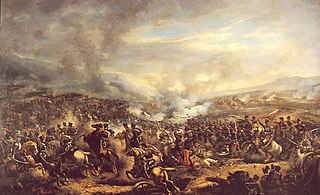
The Battle of El Roble was fought on the Itata river, 17 October 1813, between the Chilean patriot general José Miguel Carrera and Spanish royalist forces under the command of Clemente Lantaño and Luis Urrejola. The surprise patriot victory at El Roble as a result of Bernardo O'Higgins' actions at the end of the day was to result in a change of patriot commander, and a severe split within the patriot movement.
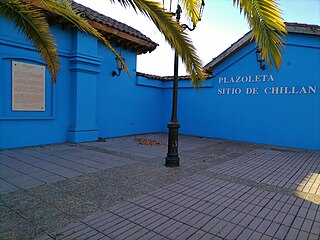
The siege of Chillán occurred from July 27th to August 10th, 1813, as patriot forces attempted to dislodge a determined band of royalist defenders. The failure of José Miguel Carrera to take the city would contribute to his removal from office by the junta later in the campaign.
The battle of Quechereguas occurred on 8 April 1814, during the War of Chilean Independence.
The battle of Membrillar occurred on 20 March 1814, during the War of Chilean Independence.
The Battle of El Quilo, fought during the Chilean War of Independence, occurred at el Quilo, on the southern side of the Itata river, on 19 March 1814.
The battle of Leeds took place during the First English Civil War on 23 January 1643, when a Parliamentarian force attacked the Royalist garrison of Leeds, Yorkshire. The attack was partly dictated by the need to maintain local support for the Parliamentarian cause; the Earl of Newcastle had recently shifted the balance of power in Yorkshire in the Royalists' favour with the addition of his 8,000-strong army, and sent one of his commanders, Sir William Savile to capture Leeds. The West Riding of Yorkshire relied on the cloth trade, and Ferdinando, Lord Fairfax sent his son, Sir Thomas Fairfax to bolster the defences of nearby Bradford, before agreeing to his request to attack Leeds.
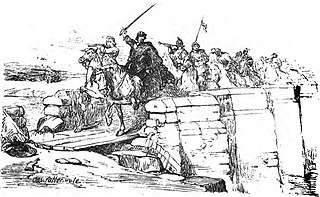
The Battle of Upton was fought on 28 August 1651 when a New Model Army detachment under the command of Colonel John Lambert made a surprise attack on Royalists defending the river Severn crossing at Upton-upon-Severn, 6 miles (9.7 km) below Worcester. In the action which followed the Royalist commander Major General Edward Massey was severely wounded and the surviving Royalists were driven out of the town and north along the Worcester Road.

The siege of Kilkenny was the isolation and capture of the fortified capital of the Irish Confederates by the New Model Army of the English Parliamentarians in March 1650 during the conquest of Ireland by Oliver Cromwell.













